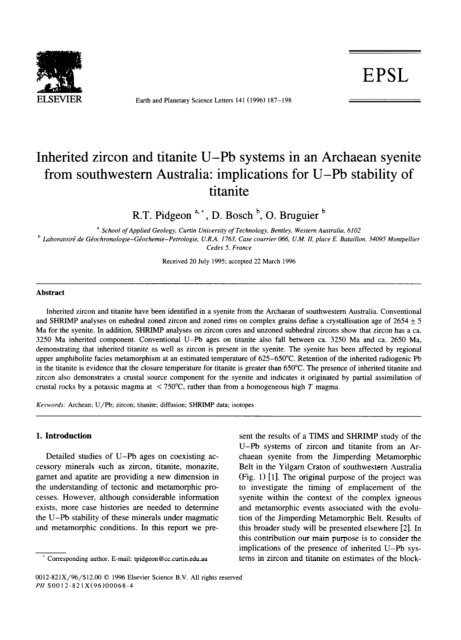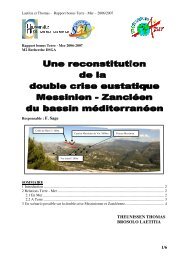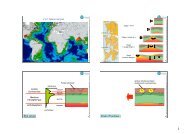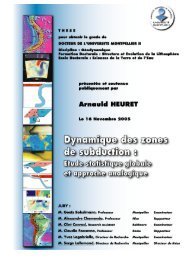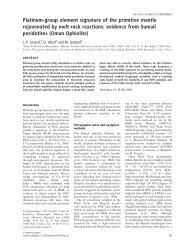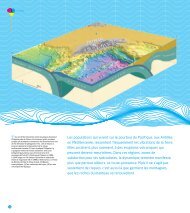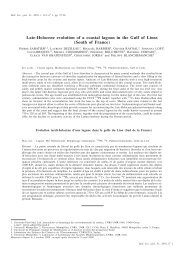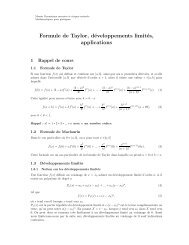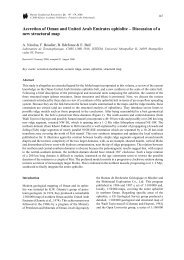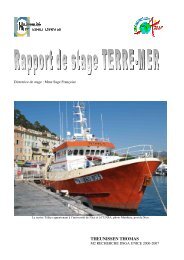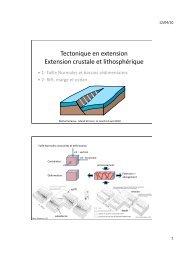Géochronologie U-Pb par ablation laser et ICP-MS (LA-ICP-MS ...
Géochronologie U-Pb par ablation laser et ICP-MS (LA-ICP-MS ...
Géochronologie U-Pb par ablation laser et ICP-MS (LA-ICP-MS ...
Create successful ePaper yourself
Turn your PDF publications into a flip-book with our unique Google optimized e-Paper software.
EPSL<br />
ELSEVIER Earth and Plan<strong>et</strong>ary Science L<strong>et</strong>ters 141 (1996) 187-198<br />
Inherited zircon and titanite U-<strong>Pb</strong> systems in an Archaean syenite<br />
from southwestern Australia: implications for U-<strong>Pb</strong> stability of<br />
titanite<br />
R.T. Pidgeon a, * , D. Bosch b, 0. Bruguier b<br />
a School of Applied Geology, Curtin University of Technology, Bentley. Western Australia. 6102<br />
b Laboratoire’ de GPochronologie-Giochemie-P<strong>et</strong>rologie, U.R.A. 1763, Case courrier 066, U.M. II, place E. Bataillon, 34095 Montpellier<br />
Cedex 5, France<br />
Received 20 July 1995; accepted 22 March 1996<br />
Abstract<br />
Inherited zircon and titanite have been identified in a syenite from the Archaean of southwestern Australia. Conventional<br />
and SHRIMP analyses on euhedral zoned zircon and zoned rims on complex grains define a crystallisation age of 2654 f 5<br />
Ma for the syenite. In addition, SHRIMP analyses on zircon cores and unzoned subhedral zircons show that zircon has a ca.<br />
3250 Ma inherited component. Conventional U-W ages on titanite also fall b<strong>et</strong>ween ca. 3250 Ma and ca. 2650 Ma,<br />
demonstrating that inherited titanite as well as zircon is present in the syenite. The syenite has been affected by regional<br />
upper amphibolite facies m<strong>et</strong>amorphism at an estimated temperature of 625-650°C. R<strong>et</strong>ention of the inherited radiogenic <strong>Pb</strong><br />
in the titanite is evidence that the closure temperature for titanite is greater than 650°C. The presence of inherited titanite and<br />
zircon also demonstrates a crustal source component for the syenite and indicates it originated by <strong>par</strong>tial assimilation of<br />
crustal rocks by a potassic magma at < 75O”C, rather than from a homogeneous high T magma.<br />
Keywords: Archean; U/<strong>Pb</strong>; zircon; titanite; diffusion;<br />
SHRIMP data; isotopes<br />
1. Introduction<br />
D<strong>et</strong>ailed studies of U-<strong>Pb</strong> ages on coexisting accessory<br />
minerals such as zircon, titanite, monazite,<br />
garn<strong>et</strong> and apatite are providing a new dimension in<br />
the understanding of tectonic and m<strong>et</strong>amorphic processes.<br />
However, although considerable information<br />
exists, more case histories are needed to d<strong>et</strong>ermine<br />
the U-PI, stability of these minerals under magmatic<br />
and m<strong>et</strong>amorphic conditions. In this report we pre-<br />
_ Corresponding<br />
author. E-mail: tpidgeon@cc.curtin.edu.au<br />
sent the results of a TI<strong>MS</strong> and SHRIMP study of the<br />
U-<strong>Pb</strong> systems of zircon and titanite from an Archaean<br />
syenite from the Jimperding M<strong>et</strong>amorphic<br />
Belt in the Yilgam Craton of southwestern Australia<br />
(Fig. 1) [l]. Th e o nginal . purpose of the project was<br />
to investigate the timing of emplacement of the<br />
syenite within the context of the complex igneous<br />
and m<strong>et</strong>amorphic events associated with the evolution<br />
of the Jimperding M<strong>et</strong>amorphic Belt. Results of<br />
this broader study will be presented elsewhere [2]. In<br />
this contribution our main purpose is to consider the<br />
implications of the presence of inherited U-<strong>Pb</strong> systems<br />
in zircon and titanite on estimates of the block-<br />
0012-821X/96/$12.00 0 1996 Elsevier Science B.V. All rights reserved<br />
PII SOOl2-821X(96)00068-4


